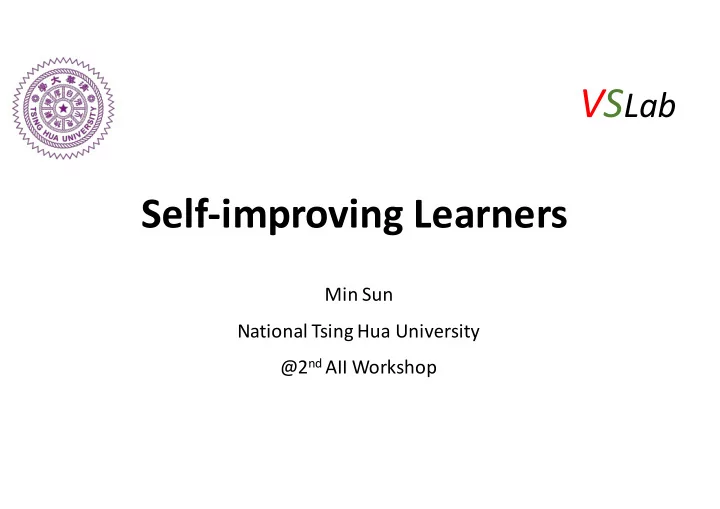

VS Lab Self-improving Learners Min Sun National Tsing Hua University @2 nd AII Workshop
Ch Challen enges es of Moder ern AI • Large-scale labelled dataset
Ch Challen enges es of Moder ern AI • Large-scale labelled dataset • Talent Intensive Workforce
We Weapons to Tackle the Challenges • Sensory data from realistic user scenarios
We Weapons to Tackle the Challenges • Sensory data from realistic user scenarios • Exponential trends in computing
Ou Outline • Self-Supervised Learning of Depth from 360◦ Videos (Sensory, Pitch) • DPP-Net: Device-aware Progressive Search for Pareto- optimal Neural Architectures (Compute)
VS Lab Self-Supervised Learning of Depth from 360◦ Videos Min Sun National Tsing Hua University Under Submission
Ou Our Go Goal 1. Well-Calibrated 360 Vision 2. Low-Cost 3. High-Resolution 4. Large FoV 𝟒𝟕𝟏° Image credits: https://hackernoon.com/mit-6-s094-deep-learning-for-self-driving-cars-2018-lecture-2-notes-e283b9ec10a0
I : Equirectangular Ou Our Model I : Cube D: Depth P: Camera motion Q: Point Cloud 𝑹 𝟐 𝑱 𝟐 DNet 𝑬 𝟐 [1] PNet 𝑸 𝟐 𝑸 𝟐 𝑸 𝟑 𝑸 𝟑 R, T 𝑱 𝟑 [1] Zhou et al., Unsupervised Learning of Depth and Ego-Motion from Video, CVPR 2017
Da Dataset – Pa PanoSUNCG Frame Inverse Depth Frame Inverse Depth Frame Inverse Depth 𝑢 , 𝑢 - 𝑢 , 𝑢 -
Qu Quantitative Results – De Depth
Ef Efficiency – Sp Speedup Ratio
Qu Qualitative Results – Pa PanoSUNCG Frame EQUI Ours GT
Qu Qualitative Results – Re Real-wo world Videos Frame Our prediction Frame Our prediction
DPP PP-Ne Net: : De Device-aw awar are Progressive Search for Pareto- Pr op optimal Neural Architectures Jin-Dong (Mark) Dong 1 , An-Chieh Cheng 1 , Da-Cheng Juan 2 , Wei Wei 2 , Min Sun 1 National Tsing-Hua University 1 Google 2 ICLR Workshop 2018 https://markdtw.github.io/pppnet.html Slides by Mark : markdtw
Ho Hot Trend - Ne Neural Architecture Search • Barret Zoph, et al. “Neural Architecture Search with Reinforcement Learning”, In ICLR 2017 NAS used 800 GPUs for 28days • Irwan Bello, et al. “Neural Optimizer Search with Reinforcement Learning”, In ICML 2017 NASNet used 450 GPUs for 3-4 days (i.e. 32,400- 43,200 GPU hours) • Hieu Pham, et al. “Efficient Neural Architecture Search via Parameter Sharing”, In ArXiv 2018 ENAS used 1 GTX1080Ti for 10 hours
Wh What’s Missing Current works mostly focus on achieving high classification accuracy ● regardless of other factors. single objective -> multi-objectives (accuracy, inference time, etc) Demands for ubiquitous model inference is rising. However, designing ● suitable NNs for all devices (HPC, cloud, embedded system, mobile phone, etc.) remain challenging. Therefore, we aim at automatically design such models for different ● devices considering multiple objectives .
Ou Our Approach: Sea Search Sp Space Cell repetitions C and growth rate G Cells are connected following ● CondenseNet by Huang et al. (1) layers with different resolution are also directly connected. (2) growth rate G doubles when the feature map shrinks. This connection scheme improves ● the computational efficiency.
Ou Our Approach: Sea Search Sp Space Designed a new cell search space that covers famous compact CNNs. ● Search for a cell instead of a whole architecture. ●
Ou Our Approach: Sea Search Al Algorithm Sequential Model-based Optimization. ● - Sequential: Progressively add layers. - Model-based: RNN Regressor -> predict accuracy. Select K Networks: Pareto Optimality ●
Ex Experiment Settings gs Test DPP-Net on 3 different devices . ● Train on CIFAR-10. ●
CI CIFAR-10 10 Experim iment
CI CIFAR-10 10 Experim iment DPP-Net-PNAS selects the model with highest accuracy. ●
CI CIFAR-10 10 Experim iment DPP-Net-PNAS selects the model with highest accuracy. ● DPP-Net- Device- A runs the fastest on certain device . ●
CI CIFAR-10 10 Experim iment DPP-Net-PNAS selects the model with highest accuracy. ● DPP-Net- Device- A runs the fastest on certain device . ● DPP-Net-Panacea performs relatively good on every objectives. ●
Im Image geNet Ex Experiment DPP-Net-Panacea outperforms CondenseNet in every objectives except ● number of params and memory usage.
Im Image geNet Ex Experiment DPP-Net-Panacea outperforms CondenseNet in every objectives except ● number of params and memory usage. DPP-Net-Panacea outperforms NASNet-A in every objectives ●
Co Conclusion Use largely available sensory data (w/o label) to self-improve your ● systems Leverage exponential increase of computation to reduce the effort of ● talents
Recommend
More recommend